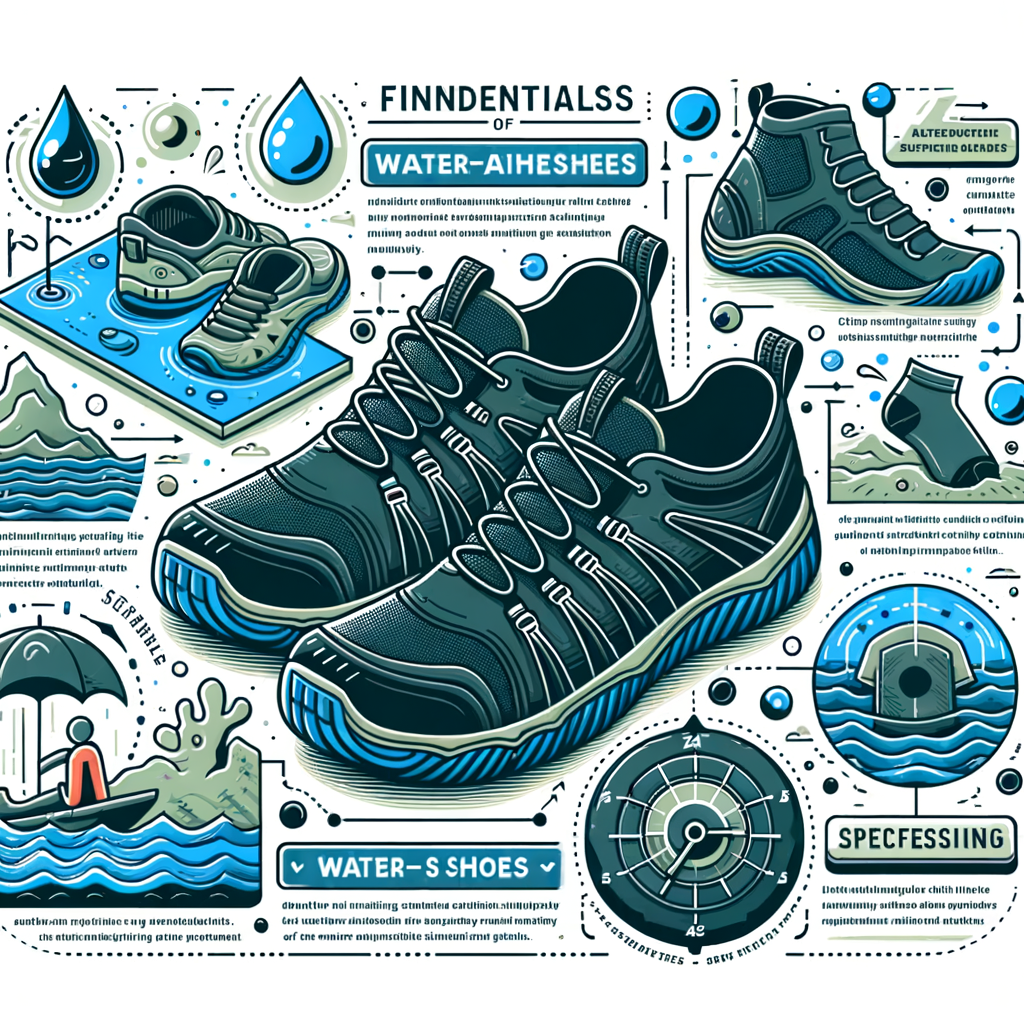
Introduction to Water Shoes Basics
Water shoes are an essential part of any water-based activity. This article will provide a basic introduction to water shoes, including their definition, history, and why they are so important for water activities.
- Definition of Water Shoes
- History and Evolution of Water Shoes
- Why Water Shoes are Essential for Water Activities
Water shoes, also known as aqua shoes or swim shoes, are a type of footwear specifically designed for activities that involve water. They are made from quick-drying materials and usually have a hard sole to protect the feet from sharp objects. Unlike regular shoes, water shoes are meant to be worn in the water, providing the wearer with grip and foot protection.
The concept of water shoes has been around for centuries, with early versions made from animal skins or plant materials. However, the modern water shoe as we know it today was not developed until the late 20th century. The evolution of water shoes has been driven by advancements in materials and design, with today’s water shoes being lightweight, durable, and comfortable.
Water shoes are essential for many water activities for several reasons. Firstly, they provide protection. Whether you’re walking on a rocky beach or swimming in a sea full of sharp corals, water shoes can protect your feet from cuts and bruises. Secondly, they offer grip. Water shoes are designed to prevent slipping on wet surfaces, making them ideal for activities like kayaking or paddleboarding. Lastly, they provide comfort. Unlike regular shoes, water shoes are designed to be worn in water, meaning they won’t become heavy or uncomfortable when wet.
In conclusion, water shoes are a vital piece of equipment for anyone who enjoys water activities. They offer protection, grip, and comfort, making them an essential part of any water enthusiast’s kit.
Understanding Footwear: The Fundamentals
Footwear is more than just a fashion statement. It’s a complex piece of engineering designed to protect and support your feet as you move. Let’s dive into the basics of footwear, starting with the anatomy of a shoe.
Understanding the Anatomy of a Shoe
Every shoe, whether it’s a water shoe, a running shoe, or a dress shoe, is made up of several key components. Understanding these parts can help you make better choices when it comes to selecting the right footwear for your needs.
- Upper Part
- Sole
- Insole and Midsole
- Heel
The upper part of a shoe is the material that covers the top of the foot. This can be made from a variety of materials, including leather, textile, or synthetic materials. The upper part is often designed to provide comfort, support, and style.
The sole is the bottom part of the shoe that comes into direct contact with the ground. It’s usually made from rubber or a similar material that provides grip and absorbs shock. The sole is crucial for providing traction and preventing slips and falls.
The insole is the interior bottom of a shoe, where your foot rests. It’s often cushioned for comfort. The midsole, located between the insole and the outer sole, provides additional shock absorption and support. These parts play a significant role in a shoe’s comfort and performance.
The heel is the rear part of the shoe under the heel of your foot. The height and shape of the heel can vary greatly depending on the type of shoe. In water shoes, the heel is typically low to provide stability and prevent ankle rolling.
Understanding these fundamental parts of a shoe can help you make an informed decision when choosing footwear. Whether you’re hiking, running, or walking near water, the right shoe can make all the difference in comfort and performance.
Fundamentals of Footwear: Materials Used
When it comes to footwear, especially water shoes, the materials used play a significant role in determining the shoe’s comfort, durability, and functionality. Let’s take a closer look at the most commonly used materials in shoe manufacturing.
- Leather
- Textiles
- Rubber
- Synthetics
Leather is a traditional material used in shoe production. It’s known for its durability and ability to mold to the wearer’s foot shape over time, providing a personalized fit. Leather shoes are often waterproofed to enhance their suitability for water-based activities.
Textiles, such as cotton or synthetic fabrics, are often used in shoe production for their breathability and flexibility. They are lightweight, making them a popular choice for water shoes. However, they may not offer the same level of durability as leather or rubber.
Rubber is a key material in footwear, particularly in the production of soles. It provides excellent grip and waterproof qualities, making it ideal for water shoes. Rubber is also highly durable and can withstand rough terrains and harsh conditions.
Synthetic materials, such as plastic and synthetic leather, are increasingly used in shoe production. These materials are lightweight and often cheaper than natural materials. They can be waterproofed and are often used in the upper parts of water shoes for their quick-drying properties.
Understanding the materials used in your footwear can help you make an informed decision when choosing your next pair of water shoes. Remember, the right material can enhance your comfort and performance, whether you’re walking on a beach or navigating a rocky riverbed.
Importance of Water Shoes: The Essential Water Footwear
Water shoes are more than just a fashion statement. They play a crucial role in protecting our feet in various water-related activities. Let’s delve into the specifics of how these shoes safeguard our feet.
Role of Water Shoes in Protecting Feet
Water shoes are designed with specific features that provide protection to our feet in different ways. Here are some of the key roles they play:
- Protection Against Sharp Objects
- Prevention of Slips and Falls
- Protection Against Cold Water Temperatures
When you’re walking on the beach or swimming in the sea, there’s always a risk of stepping on sharp objects like shells, rocks, or even broken glass. Water shoes have thick soles that provide a protective layer between your feet and these harmful objects, reducing the risk of injuries.
Wet surfaces are often slippery, and it’s easy to lose your footing. Water shoes are made with special non-slip soles to provide better traction on wet surfaces, helping to prevent slips and falls. This feature is particularly useful when you’re walking on wet rocks or slippery pool sides.
If you enjoy water activities in colder climates, you’ll know how uncomfortable it can be for your feet. Water shoes provide an extra layer of insulation, helping to keep your feet warm in cold water. This not only enhances your comfort but also reduces the risk of conditions like hypothermia.
In conclusion, water shoes are an essential piece of footwear for anyone who enjoys water activities. They provide protection against sharp objects, help prevent slips and falls, and keep your feet warm in cold water. So, next time you’re planning a trip to the beach, don’t forget to pack your water shoes!
Health Benefits of Wearing Water Shoes
Water shoes are more than just a fashion statement or a convenience for water-based activities. They also offer several health benefits that can significantly improve your overall foot health. Let’s delve into some of these benefits:
- Prevents Fungal Infections
- Reduces Risk of Athlete’s Foot
- Improves Foot Health
Water shoes are designed to dry quickly, reducing the damp environment that fungi thrive in. This helps to prevent fungal infections such as athlete’s foot and toenail fungus. According to a study by the American Academy of Dermatology, nearly 3% of the U.S. population suffers from fungal foot infections annually. By wearing water shoes, you can significantly reduce your risk.
Athlete’s foot is a common fungal infection that causes itching, scaling, and redness. It’s often contracted by walking barefoot in damp, public places like swimming pools or locker rooms. Water shoes create a protective barrier between your feet and the floor, reducing your risk of contracting this uncomfortable condition.
Water shoes provide excellent support and cushioning, which can help to improve your overall foot health. They can help to alleviate foot pain and discomfort, especially when walking on uneven surfaces. Furthermore, they can help to improve your balance and stability, reducing the risk of slips and falls.
In conclusion, water shoes are an essential piece of footwear for anyone who enjoys water activities. Not only do they protect your feet from sharp objects and cold temperatures, but they also offer several health benefits. So the next time you’re heading to the beach or the pool, don’t forget your water shoes!
Water Shoes Function: More Than Just Footwear
Water shoes are a unique type of footwear designed to keep your feet safe and comfortable during water activities. But they’re more than just shoes. They’re a crucial part of your water sports gear, providing protection, grip, and comfort in different water environments.
Water Shoes for Different Water Activities
Let’s explore how water shoes function in various water activities:
- Swimming: Water shoes aren’t typically used for swimming in a pool, but they’re essential for swimming in natural bodies of water. They protect your feet from sharp rocks, shells, and other underwater hazards. Plus, they provide extra grip when walking on slippery surfaces.
- Surfing: Surfing requires balance and grip, and that’s where water shoes come in. They provide excellent traction on the surfboard, preventing slips and falls. They also protect your feet from sharp coral and sea creatures.
- Water Aerobics: Water shoes are a must for water aerobics. They provide the necessary grip on the pool floor, allowing you to perform exercises without slipping. They also offer support and cushioning, reducing the impact on your joints.
- Boating: On a boat, surfaces can be slippery. Water shoes provide excellent traction, preventing slips and falls. They also protect your feet from sharp objects and provide cushioning for comfort during long boating trips.
As you can see, water shoes are more than just footwear. They’re a functional piece of equipment that enhances your performance and safety in various water activities.
Water Shoes Vs. Regular Shoes
When it comes to footwear, not all shoes are created equal. This is especially true when comparing water shoes to regular shoes. Let’s dive into the key differences between these two types of footwear in terms of material, function, and design.
- Differences in Material
- Differences in Function
- Differences in Design
Water shoes are typically made from quick-drying, breathable materials like mesh or neoprene. These materials are designed to drain water quickly, preventing your feet from staying wet and uncomfortable. On the other hand, regular shoes are usually made from materials like leather or canvas that are not designed to handle water well. These materials can absorb water, making the shoes heavy and uncomfortable when wet.
Water shoes are designed for activities that involve water. They provide traction on wet and slippery surfaces, protect your feet from sharp objects, and keep your feet comfortable in wet conditions. Regular shoes, however, are designed for dry conditions. They provide comfort and support for walking, running, or standing, but they may not perform well in wet conditions.
Water shoes often have a unique design that sets them apart from regular shoes. They usually have a thick, sturdy sole for protection and traction, and a lightweight, breathable upper for comfort. Some water shoes even have a toe guard for extra protection. Regular shoes, on the other hand, come in a wide variety of designs depending on their intended use. For example, running shoes are designed for speed and comfort, while work boots are designed for durability and protection.
In conclusion, while water shoes and regular shoes may look similar, they are designed for very different purposes. Understanding these differences can help you choose the right footwear for your needs.
Water Shoes Guide: Choosing the Right Pair
Choosing the right pair of water shoes can greatly enhance your comfort and safety during water-based activities. There are several factors to consider when purchasing water shoes. Let’s delve into these factors.
Factors to Consider When Buying Water Shoes
- Size and Fit
- Material
- Design and Style
- Price
The most important factor to consider when buying water shoes is the size and fit. Shoes that are too tight can cause discomfort, while those that are too loose can slip off in the water. Make sure to try on different sizes and choose the one that fits you best. Remember, your feet may swell a bit when wet, so it’s a good idea to choose a size that gives your toes some wiggle room.
The material of the water shoes is another crucial factor. Most water shoes are made of quick-drying materials like mesh or neoprene. These materials are lightweight, breathable, and dry quickly, making them ideal for water activities. However, if you plan to use the shoes for hiking or other rough terrains, consider shoes with a thicker sole for extra protection.
Water shoes come in various designs and styles. Some are designed like sandals, while others look like regular sneakers. The design you choose should depend on your personal preference and the type of activities you plan to do. If you plan to swim, a slip-on design might be more suitable. On the other hand, if you plan to hike, a shoe with a secure strap might be a better choice.
Last but not least, consider the price. Water shoes can range from affordable to quite expensive. It’s important to set a budget and stick to it. However, don’t sacrifice quality for the sake of saving a few dollars. Remember, a good pair of water shoes is an investment in your comfort and safety.
Top Brands for Water Shoes
When it comes to water shoes, there are several brands that stand out due to their quality, durability, and design. Here are the top three brands that are highly recommended for their excellent water shoes:
- Brand A
- Brand B
- Brand C
Brand A is a well-known brand in the footwear industry. They offer a wide range of water shoes that are not only stylish but also comfortable and durable. Their water shoes are designed with a quick-drying material that makes them perfect for water activities. They also have a non-slip sole for added safety.
Brand B is another top-rated brand for water shoes. They are known for their innovative designs and high-quality materials. Their water shoes are lightweight and have a breathable mesh upper that keeps your feet cool and dry. They also offer a variety of colors and styles to choose from.
Brand C is renowned for their high-performance water shoes. They use advanced technology to create water shoes that provide excellent traction in wet and slippery conditions. Their water shoes also have a cushioned footbed for extra comfort and support.
These brands have proven their worth in the market and have received positive reviews from customers. When choosing a pair of water shoes, consider these brands for their quality, comfort, and durability.
Conclusion: Enhancing Your Water Shoes Knowledge
As we wrap up this comprehensive guide on water shoes, let’s revisit some of the key points we’ve discussed and look forward to how you can continue to expand your knowledge on this essential footwear.
- Recap of the Importance of Water Shoes
Water shoes are more than just footwear; they are a crucial part of your gear when engaging in water activities. They protect your feet from sharp objects, hot surfaces, and slippery underwater surfaces. They also provide comfort and support, making your water adventures more enjoyable.
- Final Thoughts on Choosing the Right Water Shoes
Choosing the right pair of water shoes can make a significant difference in your water activities. Remember, the best water shoes for you depend on the type of activity you’ll be doing, the conditions you’ll be in, and your personal comfort preferences. Always consider factors such as material, fit, grip, and drainage capabilities when making your selection.
- Encouragement for Continuous Learning about Footwear for Water Activities
Just as water activities continue to evolve, so does the footwear designed for them. Stay informed about the latest developments in water shoes to ensure you’re always equipped with the best gear. Read reviews, follow footwear blogs, and engage in discussions with fellow water activity enthusiasts. Your feet will thank you for it!
In conclusion, understanding the importance of water shoes and how to choose the right pair can significantly enhance your water activities. So, keep learning, stay informed, and enjoy your water adventures to the fullest!









